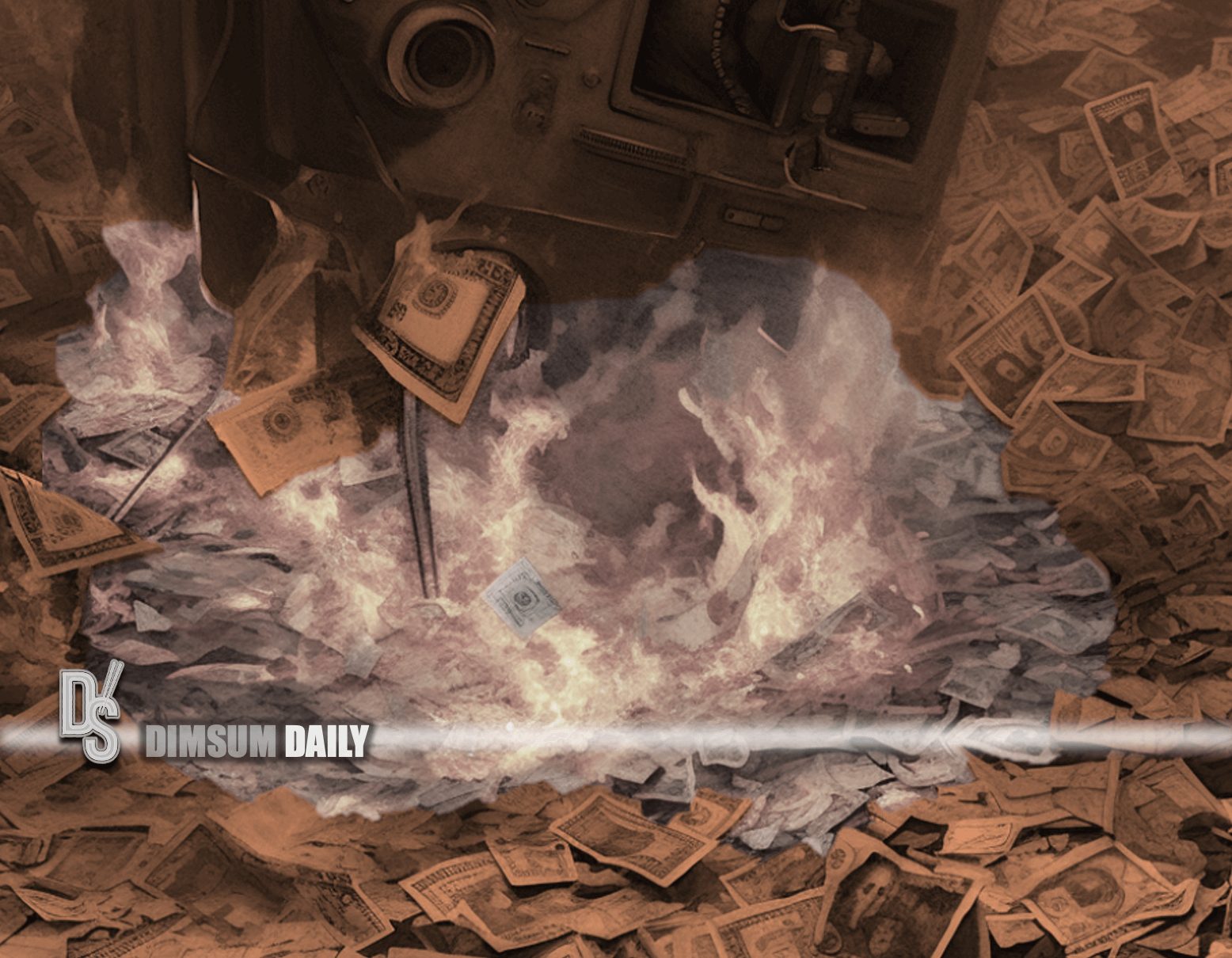14th April 2025 – (New York) Economic orthodoxy holds that tariffs should strengthen a nation’s currency by reducing imports and theoretically improving the trade balance. Yet the U.S. dollar’s precipitous decline — plummeting to three-year lows against the euro and surrendering 10% of its value since January — defies conventional wisdom in spectacular fashion. This anomaly reveals a deeper truth: President Trump’s trade offensive has inadvertently triggered a crisis of confidence in dollar-denominated assets so severe that it threatens the very foundations of American financial hegemony. The mechanics of this unravelling are both complex and illuminating, exposing how tariff brinksmanship has mutated into a full-blown currency crisis with ramifications far beyond trade flows.
The dollar’s freefall gained alarming momentum in April as currency markets digested the implications of Trump’s so-called Liberation Day tariffs — a sweeping 10% baseline levy on all imports punctuated by punitive rates exceeding 100% for targeted nations. Conventional models failed to anticipate the violent market reaction: instead of capital fleeing to traditional dollar safe havens, investors staged an unprecedented synchronized retreat from US equities, Treasuries and the currency itself. This triad of declines — normally mutually exclusive in crisis periods — signals a fundamental reassessment of America’s risk profile. The dollar index’s 3% weekly plunge against major currencies represents the most severe depreciation since the 2008 financial crisis, with the euro surging to $1.14 (a threshold unseen since the Ukraine war’s outbreak) and the Swiss franc reaching decade highs. Currency strategists at Union Bancaire Privée identify European investors leading this capital repatriation, converting dollar holdings en masse as confidence in US economic stability evaporates.
This loss of faith manifests most dangerously in the Treasury market’s anomalous behaviour. Ten-year yields spiked 38 basis points in a single week — the sharpest ascent since 1982 — even as the dollar weakened, violating the traditional inverse relationship between the currency and government debt. Normally, Treasury instruments benefit from haven demand during periods of dollar weakness; their concurrent decline suggests investors now perceive US sovereign debt as carrying latent risk rather than offering refuge. ING’s forex strategists describe this paradigm shift in stark terms: “The question of a potential dollar confidence crisis has now been definitively answered — we are experiencing one in full force.” Germany’s bund market has become the unlikely beneficiary, with yields compressing as capital seeks European stability — a role reversal that would have been unthinkable eighteen months ago.
The tariff policy’s corrosive impact operates through multiple transmission channels. First, by threatening to tip the US into recession — Allianz economists estimate a 60% probability — Trump’s measures have undermined the growth premium that traditionally supports dollar strength. Second, the administration’s erratic policy reversals (including the partial 90-day tariff pause) have shattered predictability, a cornerstone of reserve currency status. Former IMF chief economist Raghuram Rajan notes that markets can adjust to consistent protectionism, but whipsawing measures create “Knightian uncertainty” where investors cannot rationally price risk. Most critically, the tariffs expose structural vulnerabilities in America’s exorbitant privilege: the ability to fund persistent trade deficits through dollar demand. As DWS analysts observe, global investors are unwinding “one-sided dollar positioning” that had persisted for decades, recognising that tariff-induced trade contraction could permanently reduce offshore dollar liquidity.
The euro’s resurgence epitomises this rebalancing. While the European Central Bank maintains negative real rates, the common currency has appreciated 7% against the dollar this quarter — a move ING attributes purely to dollar weakness rather than euro strength. Some forecasts now envision parity at 1.20 by 2026 should capital rotations persist. This reflects not eurozone vitality but rather the dollar’s diminishing gravitational pull as the global financial system’s anchor. Even more telling are developments in commodity markets, where gold’s surge past $3,000/oz and Bitcoin’s resurgence signal a broad-based retreat from fiat currencies amid dwindling confidence in the rules-based monetary order.
Historical parallels compound these concerns. The 1930 Smoot-Hawley tariffs demonstrated how protectionism can accelerate currency crises by disrupting trade settlement flows — a lesson modern policymakers appear to have forgotten. Trump’s measures risk replicating this dynamic at scale: J Safra Sarasin economists warn that tying dollar access to trade alignment (a so-called “Mar-a-Lago Accord”) could Balkanize global finance into competing currency blocs. Early signs suggest this fragmentation has already begun, with Asian central banks discreetly increasing yuan reserves and the ECB quietly testing euro-based alternatives to dollar payment systems.
The ultimate irony lies in the administration’s strategic miscalculation. By weaponising trade, Washington has inadvertently weakened the very dollar dominance that enabled its tariff offensive. As former U.S. Treasury official Mark Sobel notes, “Trump is undermining the institutional foundations that made dollar supremacy possible.” With each tariff escalation, America’s capacity to externalise the costs of protectionism diminishes — a reality now reflected in currency markets. The Federal Reserve faces an impossible trilemma: defend the dollar through rate hikes and crush indebted corporates, or accept currency depreciation and import inflation that erodes living standards.
For global investors, the implications are profound. The dollar’s retreat from its exorbitant privilege won’t resemble Argentina’s peso collapse but rather a gradual corrosion — a “boiling frog” scenario where reserve managers diversify holdings across euros, yen and gold without dramatic announcements. Already, IMF data shows the dollar’s share of global reserves falling below 58% — the lowest since the euro’s introduction — while the ECB reports surging demand for euro-denominated debt issuance. This reallocation may accelerate as tariff uncertainty persists, with UBP strategists noting “structural de-dollarization is now pricing into cross-asset correlations.”
A reserve currency’s value ultimately rests on confidence in the issuing nation’s institutional stability and policy predictability — qualities the current administration has systematically undermined. As European central bankers quietly position the euro as a “rules-based alternative” and Asian traders increasingly bypass dollar clearing, the geopolitical ramifications become apparent. Trump’s tariffs may achieve what decades of anti-dollar rhetoric could not: convincing the world that America’s financial dominance is no longer axiomatic. In seeking to make America great again through trade wars, the administration has inadvertently precipitated the dollar’s great unravelling — a crisis with consequences that will outlast any tariff schedule.



